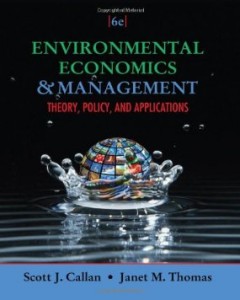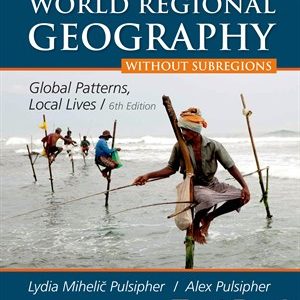Instant download Test Bank for Environmental Economics and Management Theory Policy and Applications, 6th Edition: Callan pdf docx epub after payment.

Product details:
- ISBN-10 : 1111826676
- ISBN-13 : 978-1111826673
- Author: Scott J. Callan; Janet M. Thomas
Provides an applied, practical approach to environmental economic theory that is accessible to students who have had minimal exposure to economics as well as those with an advanced understanding. With a strong focus on policy and real-world issues, Callan/Thomas’s ENVIRONMENTAL ECONOMICS AND MANAGEMENT: THEORY, POLICY AND APPLICATIONS, Fifth Edition, complements economic theory with timely, real-world applications. Undergraduate or MBA students gain a clear perspective of the relationship between market activity and the environment. This text integrates a strong business perspective into the development of environmental decision making for a unique vantage point often overlooked in more conventional approaches. Students learn to use economic analytical tools, such as market models, benefit-cost analysis, and risk analysis, effectively to assess environmental problems and to evaluate policy solutions. With a proven, modular structure, this edition provides a well-organized presentation with the flexibility to tailor the presentation to your needs.
Table Of Contents:
- Ch 1: The Role of Economics in Environmental Management
- Introduction
- Economics and the Environment
- Understanding Environmental Damage
- Identifying Environmental Objectives
- Environmental Policy Planning: An Overview
- Conclusions
- Summary
- Review Questions
- Additional Readings
- Ch 2: Modeling the Market Process: A Review of the Basics
- Introduction
- Market Models: The Fundamentals
- Modeling Supply and Demand: An Overview
- Market Demand
- Market Supply
- Market Equilibrium
- Efficiency Criteria
- Welfare Measures
- Conclusions
- Summary
- Review Questions
- Additional Readings
- Ch 3: Modeling Market Failure
- Introduction
- Environmental Problems: A Market Failure
- Environmental Quality: A Public Good
- Modeling a Public Goods Market for Environmental Quality
- Environmental Problems: Externalities
- Modeling Environmental Damage as a Negative Externality
- The Absence of Property Rights
- Conclusions
- Summary
- Review Questions
- Additional Readings
- Module 2: Modeling Solutions to Environmental Problems
- Introduction
- Ch 4: Conventional Solutions to Environmental Problems: The Command-and-Control Approach
- Introduction
- Using Standards in Environmental Policy
- Are Environmental Standards Allocatively Efficient?
- General Approaches to Implementing Environmental Policy
- Is the Command-and-Control Approach Cost-Effective?
- Conclusions
- Summary
- Review Questions
- Additional Readings
- Ch 5: Economic Solutions to Environmental Problems: The Market Approach
- Introduction
- Descriptive Overview
- Pollution Charges
- Environmental Subsidies
- Deposit/Refund Systems
- Pollution Permit Trading Systems
- Conclusions
- Summary
- Review Questions
- Additional Readings
- Module 3: Analytical Tools for Environmental Planning
- Introduction
- Ch 6: Environmental Risk Analysis
- Introduction
- Concept of Risk
- Risk Assessment
- Risk Management
- Conclusions
- Summary
- Review Questions
- Additional Readings
- Ch 7: Assessing Benefits for Environmental Decision Making
- Introduction
- Environmental Benefits: Conceptual Issues
- Approaches to Measuring Environmental Benefits: An Overview
- Estimation Under the Physical Linkage Approach
- Direct Estimation Methods Under the Behavioral Linkage Approach
- Indirect Estimation Methods Under the Behavioral Linkage Approach
- Conclusions
- Summary
- Review Questions
- Additional Readings
- Ch 8: Assessing Costs for Environmental Decision Making
- Introduction
- Environmental Costs: Conceptual Issues
- Estimation Methods for Measuring Explicit Costs
- Cost Classifications in Practice
- Conclusions
- Summary
- Review Questions
- Additional Readings
- Ch 9: Benefit-Cost Analysis in Environmental Decision Making
- Introduction
- Time Adjustments to Environmental Benefits and Costs
- The Final Analysis: Comparing Environmental Benefits and Costs
- Reservations About Benefit-Cost Analysis
- U.S. Government Support of Benefit-Cost Analysis
- Reducing Lead in Gasoline: A Real-World Example
- Conclusions
- Summary
- Review Questions
- Additional Readings
- Module 4: The Case of Air
- Introduction
- Ch 10: Defining Air Quality: The Standard-Setting Process
- Introduction
- An Overview of U.S. Air Quality Legislation
- Defining the Objectives of Air Quality Control
- Setting Standards to Define Air Quality
- Implementing the Standards
- Analysis of U.S. Air Quality Policy
- Benefit-Cost Analysis of the Clean Air Act
- Benefit-Cost Analysis of the Air Quality Standards
- Conclusions
- Summary
- Review Questions
- Additional Readings
- A Reference to Acronyms and Terms Used in Air Quality Control Policy
- Ch 11: Improving Air Quality: Controlling Mobile Sources
- Introduction
- Urban Air Pollution
- Controlling Mobile Sources
- Economic Analysis of Mobile Source Controls
- Conclusions
- Summary
- Review Questions
- Additional Readings
- A Reference to Acronyms and Terms Used in Mobile Source Control Policy
- Ch 12: Improving Air Quality: Controlling Stationary Sources
- Introduction
- Acidic Deposition
- Controlling Stationary Sources
- Economic Analysis of Stationary Source Controls
- Conclusions
- Summary
- Review Questions
- Additional Readings
- A Reference to Acronyms and Terms Used in Stationary Source Control Policy
- Ch 13: Global Air Quality: Policies for Ozone Depletion and Climate Change
- Introduction
- Ozone Depletion
- Controlling Ozone Depletion
- Economic Analysis of Ozone Depletion Policy
- Climate Change
- Policy Response to Climate Change
- Economic Analysis of Climate Change Policies
- Conclusions
- Summary
- Review Questions
- Additional Readings
- A Reference to Acronyms and Terms in Global Air Quality Control Policy
- Module 5: The Case of Water
- Introduction
- Ch 14: Defining Water Quality: The Standard-Setting Process
- Introduction
- Understanding Water Resources
- Overview of U.S. Water Quality Legislation
- Policy Objectives
- Setting Standards to Define Water Quality
- Analysis of Receiving Water Quality Standards
- Benefit-Cost Analysis of the Clean Water Act
- Conclusions
- Summary
- Review Questions
- Additional Readings
- A Reference to Acronyms and Terms in Water Quality Control Policy
- Ch 15: Improving Water Quality: Controlling Point and Nonpoint Sources
- Introduction
- Controlling Point Sources
- Analysis of the Effluent Limitations
- The POTW Funding Program
- Analysis of the POTW Funding Program
- Controlling Nonpoint Sources
- Analysis of Nonpoint Source Controls
- Market-Based Solutions
- Watershed Management
- Conclusions
- Summary
- Review Questions
- Additional Readings
- A Reference to Acronyms and Terms in Water Quality Control Policy
- Ch 16: Protecting Safe Drinking Water
- Introduction
- Overview of U.S. Drinking Water Legislation
- Setting Standards to Define Safe Drinking Water
- Economic Analysis of Safe Drinking Water Policy
- Economic Principles in Pricing Water Supplies
- Conclusions
- Summary
- Review Questions
- Additional Readings
- Reference to Acronyms and Terms in Drinking Water Control Policy
- Module 6: The Case of Solid Wastes and Toxic Substances
- Introduction
- Ch 17: Managing Hazardous Solid Waste and Waste Sites
- Introduction
- Characterizing the Hazardous Waste Problem
- Overview of U.S. Hazardous Waste Policy
- Controlling Hazardous Wastes: RCRA
- Analysis of U.S. Hazardous Waste Policy
- Overview of U.S. Hazardous Waste Site Policy
- Managing Uncontrolled Hazardous Waste Sites: Superfund
- Analysis of Superfund
- Conclusions
- Summary
- Review Questions
- Additional Readings
- A Reference to Acronyms and Terms in Hazardous Waste Control Policy
- Ch 18: Managing Municipal Solid Waste
- Introduction
- Characterizing Municipal Solid Waste
- Policy Response
- The Market for MSW Management Services
- Market Approaches to MSW Policy
- Conclusions
- Summary
- Review Questions
- Additional Readings
- A Reference to Acronyms and Terms in Municipal Solid Waste Policy
- Ch 19: Controlling Pesticides and Toxic Chemicals
- Introduction
- Overview of U.S. Pesticide Controls
- Controlling Pesticide Use
- Analysis of FIFRA
- Overview of U.S. Legislation on Toxic Chemicals
- Controlling Chemical Use
- Analysis of TSCA
- Economic Analysis and Market-Based Policy
- Conclusions
- Summary
- Review Questions
- Additional Readings
- A Reference to Acronyms and Terms in Toxic Substances Control Policy
- Module 7: Global Environmental Management
- Introduction
- Ch 20: Sustainable Development: International Environmental Agreements and International Trade
- Introduction
- Sustainable Development as a Global Objective
- Global Framework for Sustainable Development
- International Agreements to Control Transboundary Pollution
- International Trade and Environmental Protection
- Conclusions
- Summary
- Review Questions
- Additional Readings
- Ch 21: Sustainable Approaches: Industrial Ecology and Pollution Prevention
- Introduction
- Industrial Ecology
- Pollution Prevention
- Strategic Initiatives and Programs
- Conclusions
- Summary
- Review Questions
- Additional Readings
- References
- Glossary
- Index





